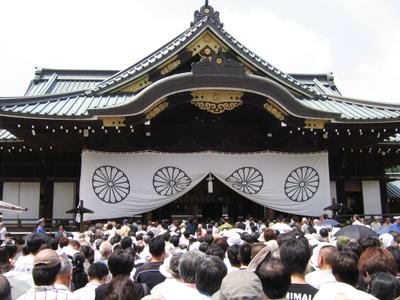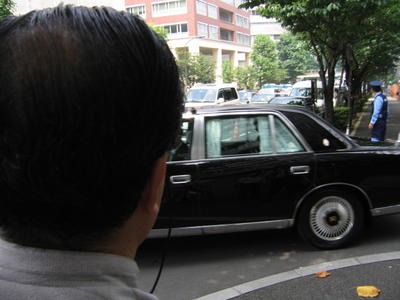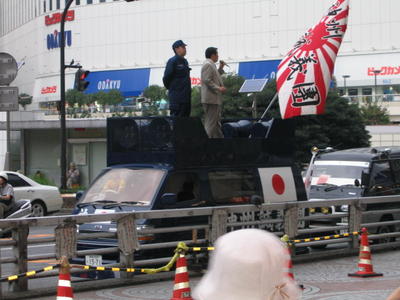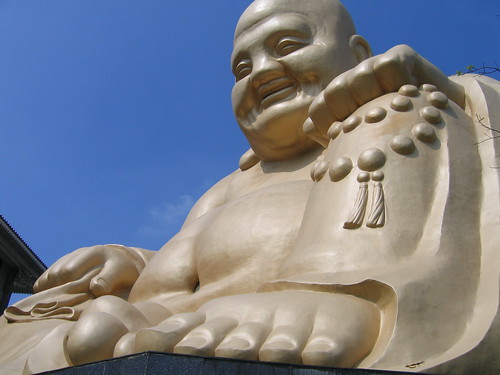 Yasukui Shrine
Yasukui Shrine
Prime Minister Koizumi zipping by (I swear, that is him inside)

Nationalist vans were all over today. This one was just outside of Shinjuku Station.
Today (August 15, 2005) was the 60th anniversary of the end of the Pacific War. I had a busy day commemorating this historic event in Tokyo.
Mr. Ozawa, the section chief (or manager – ‘kacho’) of the Public Safety Division and Mr. Ugai (another guy from the Division) guided me to Yasukuni Shrine, the Japanese National Cemetery for Japanese who died in wartime overseas and whose remains never made it home, and the HQ of Japan’s Defense Agency. Tokyo was sweltering in heat a humidity today, and the lack of a breeze made it almost unbearable, but we had a busy schedule to stick to, so we kept pushing on.
First we hit Yasukuni Shrine, the focus of international disputes between Japan on one side, and China and the Koreas on the other. Prime Minister Koizumi has visited the shrine, which honors Japan’s war dead, every year since taking office, which angers victims of Japan’s former colonial aggression. China and the Koreas are angry that seven ‘Class A’ war criminals are enshrined here – a position that is hard to argue with. Yasukuni Shrine and its supporters maintain that the Tokyo War Tribunals were a sham trial and that these men were not criminals. There is an English version of the shrine’s website that you should visit sometime (www.yasukuni.or.jp/english), but it appears to be down at the time, so keep trying back.
After waiting in line for about an hour in a mass of people in the sun with no breeze, I made it up to the shrine. I tossed in a coin, clapped my hands, and said a prayer for peace. I think this is what you are supposed to do anyway, but it just seemed like the right thing to do at this particular time and place. I got some pictures, then fought my way through the crowds to the other side of the line, where Mr. Ugai and Mr. Ozawa were waiting. We walked around to the other side of another building, just in time to see members of Japan’s Diet (the Japanese Parliament) filing into the shrine from a side entrance. I got some pictures of them, and of the media that was there to capture it as well.
There were few foreigners inside the shrine grounds, but I guess a few other curious, brave Americans besides myself made it out there. I think if we stay out of the way of the whack-job nationalist van guys, we’re OK. Japan has a very strong cultural aversion to war that has built up over the past 60 years. Most Japanese place a great deal of faith that the US-Japan Security Alliance has served Japan’s national interest by preserving Japanese national security and allowing Japan to build its economy by spending very little of its own money on national defense. They have no desire to see their country become a fascist military state again.
Then there are the whack-job nationalist van guys. I don’t know a whole lot about them, but from what I can tell, they are whack-jobs. They are closely connected with the yakuza and support ultra-conservative politicians. They want Japan to build its military and have a foreign policy independent of US domination. I don’t know who they expect to win over by yelling nationalist slogans and parading around town in black vans, but they seem to have some appeal among the mentally unstable yet highly aggressive types. They were all over town today, and I got plenty of pictures.
On our way to the Japanese National Cemetery, which is dedicated to all the Japanese nationals who died overseas in wartime but whose remains never made it home, some police wouldn’t let us take the short cut side street Mr. Ozawa had planned on using. We decided someone important must be coming soon, so rather than opting for another route, we stood by and waited. We were not disappointed. A motorcade zoomed out onto the main road, and I managed to catch a glimpse of none other than Jun-chan himself (Prime Minister Jun’ichiro Koizumi). I got a picture of his car, but you can’t see his face. Trust me, though, it was him.
After paying our respects at the cemetery, we went to the HQ of the Japan Defense Agency. This is Japan’s version of the Pentagon, so I was excited to go, but in the heat it was hard to concentrate enough to really understand most of the explanations. We walked across the grounds to a reconstructed memorial hall, which used to be an important military facility. We saw the emperor’s break room and the stage he used to ascend when addressing the top brass of the Japanese military. The real highlight for me was a trip to the second floor, where we entered the room in which Yukio Mishima committed suicide. There is an article about the suicide here that might have some good details (I am at an Internet café, so I don’t have time to read it now), but this was a meticulously planned event that deserves some studying. We covered this suicide for a day and a half in my Japanese literature class at GW, so it was amazing to actually visit the room where this happened. There is a door in the room with cuts in it from Mishima’s katana, which I also got pictures of.
After we finished touring the HQ, we got back on the trains. I parted with my coworkers and head off to Shinjuku, where I saw another black van and a Buddhist monk on the same small stretch of road. I made it to the Internet café alright, but it looked like rain, so I am afraid I might get dumped on when I leave here. Maiko and I are having dinner at Nishio-san’s again. I can’t think of a better way to end a great day than having a great meal with my girl. :)
I will try to post more by the end of the week. I am not sure what I am doing the rest of the week with my internship, but based on my experience so far, I am sure someone will fill me in with what I need to know when I need to know it.
Until then,

No comments:
Post a Comment